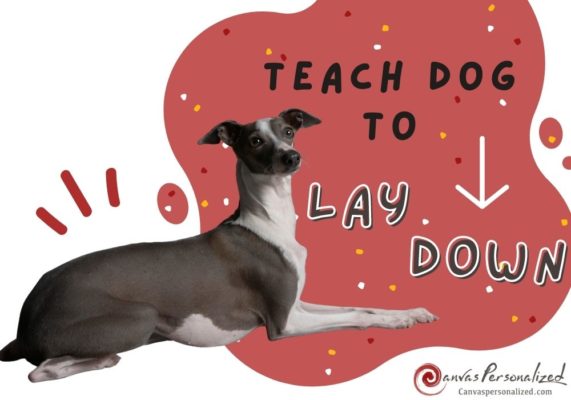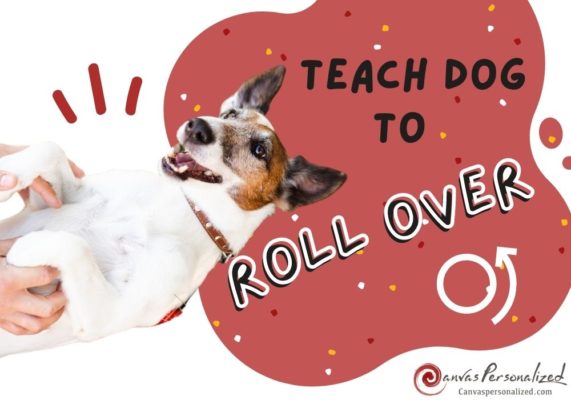Crate training for dogs is a great way to teach your puppy good behavior for its growth journey. In addition to limiting destructive activity and ensuring dogs’ safety, crate training offers a comfortable and secure place to sleep and rest.
Moreover, it can also help you develop a close bond with your dog, whether you just got it as a puppy or it’s an adult dog. Check out our best tips and tricks from Canvas Personalized for successful crate training.
Why Is Crate Training A Puppy Important?
When bringing a new puppy into your home, no matter what age or type of breed it is, you should crate train a puppy with positive reinforcement. However, the crates can be terrifying for a dog who hasn’t been trained well. Meanwhile, a well-trained crate puppy can reduce anxiety during times of crisis, such as after surgery; the dog is less likely to aggravate any injuries during the procedure.
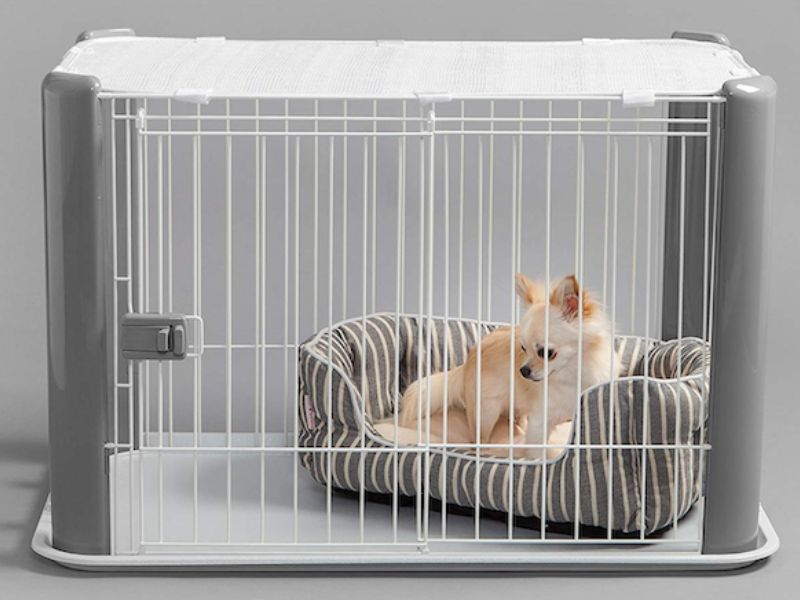
Crate training benefits all dog ages, including young pups, working dogs, and older dogs. Moreover, the benefits of crate training extend beyond the dog to the pet parents.
- Facilitates house training: During potty training or potty break, dogs are naturally den animals, so it is less likely your dog will go pee or poop there. So it would be best to take it outside frequently, including after waking up, being fed, and playing. Moreover, if you can assist your puppy in avoiding food and drinks before night sleeping, you’ll dramatically reduce nighttime potty breaks and enhance positive eating and drinking routines.
>>> Explore the best way to potty train a puppy with a comprehensive guide!
- Providing your dog with personal space: Your puppy will love to have a safe space when feeling exhausted, worried, or afraid of strangers or loud noises. Moreover, while you’re out for a long time, a crate keeps your dog from getting into electrical cords, which can be harmful if chewed.
- Recovery Zone: After post-operative care or an injury, bringing your dog to a crate will help confine your dog with ease and no stress.
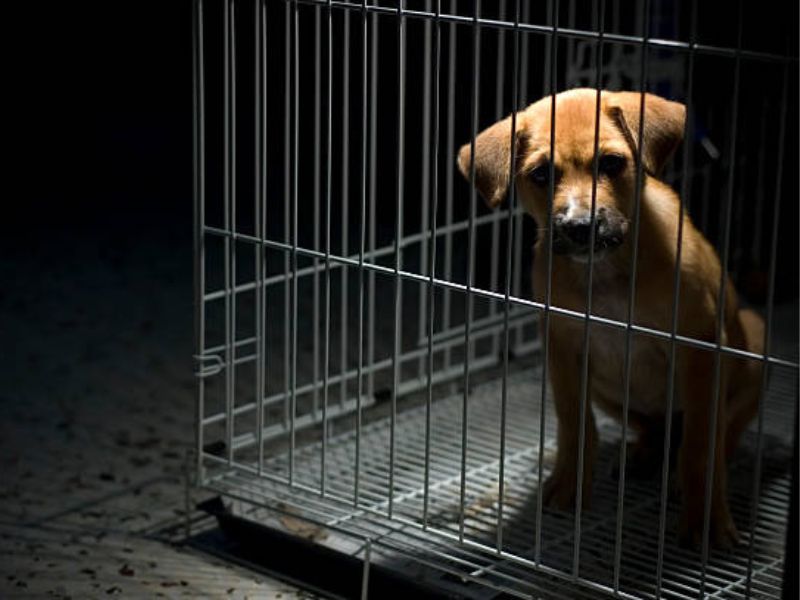
When utilized during the crate training, a puppy process, though, some dog owners use the crate as punishment once their dog makes mistakes. The crate train process isn’t “imprisoning” your dog; it is the place where your dog can relax in its area and reduce stress. So the key is to ease your puppy into the crate and not force it to get used to it before you leave it alone. And if you give your dog time to adjust to the dog crate for training on its terms, it’ll spend time calmly and happily for years to come.
Crate Training A Puppy Process
Requirement For Dog Crate For Training
Making your dog’s crate comfortable and secure is essential if you want it to become its haven. Specifically, you’ll need the following:
The Right Crate
Once you begin using a dog crate for training, you will have many crates to choose from. Choosing the right crate for your dog is easy if you keep our tips below in mind.
Most dogs will quickly adjust to any crate, but it is easier to alter the size of the interior of a wire crate by adding or removing a partition. Kennel or airplane crates are what we suggest for dogs that want to sleep in the dark, while wire crates are better for other dogs.

Selecting the right size of a puppy’s crate is the next step in learning crate training for dogs. Most puppies only need a big crate to stand up, turn around, and lie comfortably. So many pet parents should plan for their dog’s eventual crate size that they will need when fully grown.
Crate training a puppy involves more than just putting a dog in a small space. Besides that, some other types of equipment that pet parents should need to include the following:
Bedding: Bedding is essential for your dog’s comfort during crate training a puppy. Extra-plush dog beds or cozy blankets should be avoided if a puppy still needs house training.
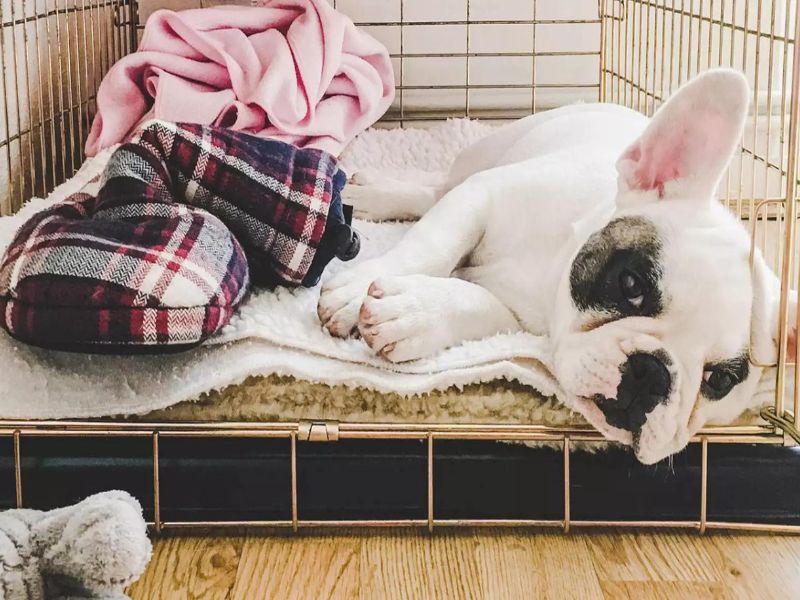
Treats: Yummy treats are vital to start crate training (and any other training you want to do with your pup, such as how to sit, stay or shake hands).
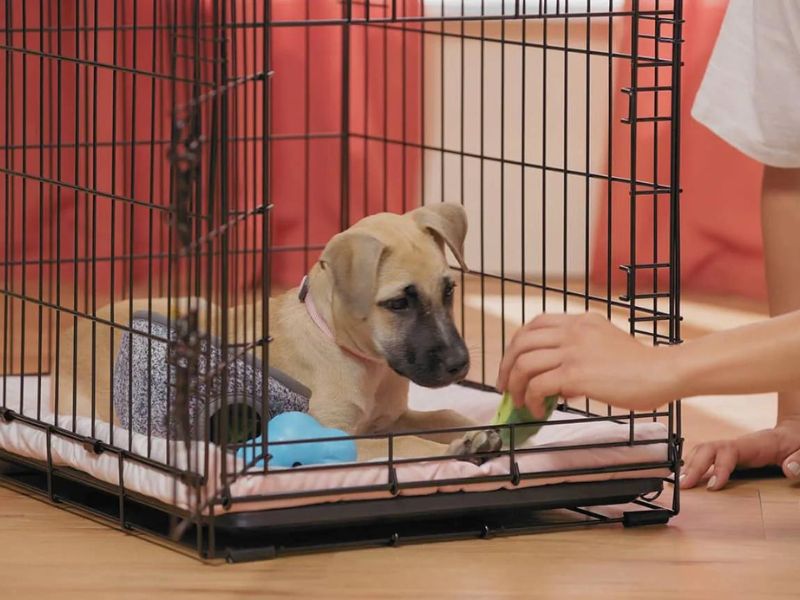
Fun Toys: It can be challenging to get hyperactive or adult dogs to relax in their crates without some distractions. This is when the use of any interactive toy comes into play. If you leave your dog alone in the house, giving it a task to complete before nighttime crate training might help it stay occupied and calm. Remember to check the durability to ensure the toy won’t break into small enough pieces that could be a choking hazard.
How To Crate Train Successful In 5 Steps?
Crate train a puppy process could take a few days or weeks, depending on your dog’s age, personality, and previous experiences. Two things must be remembered when training a dog in a dog crate. Do not rush through the training process; instead, make the crate a positive part of every training session.
Step 1: Improve Your Positive Mindset
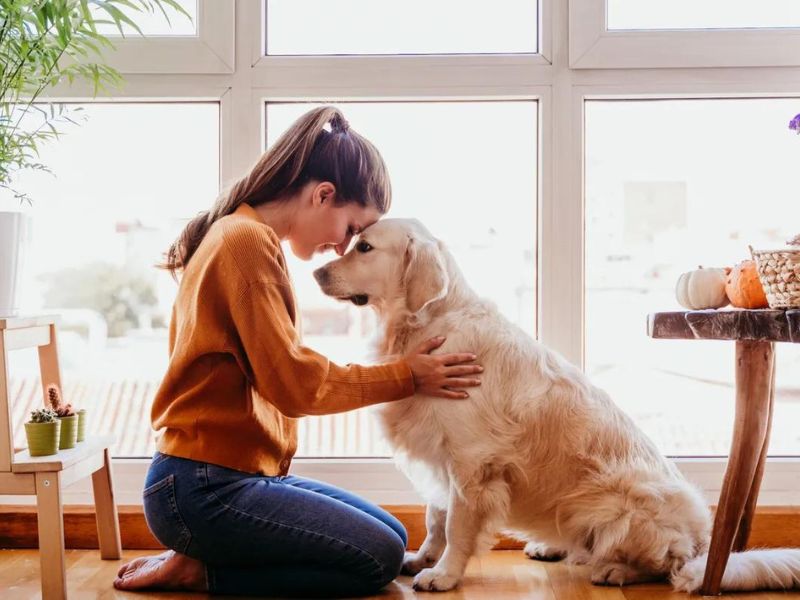
It is clear that the dogs learn the positive associations of crate training with a calm state of mind and will come to like spending time in it. If you introduce the puppy’s crate to it when it feels relaxed, it’s more probable to associate it with a time of repose. Bring them in for 10-minute intervals, gradually increasing the time.
Ensure your dog is happy and relaxed at every stage by taking as much time as needed. That’s how you get the new pup used to anticipate their positive associations crate every day.
Step 2: Introducing your dog to the crate
You can place the dog’s crate in the living room, which is provided with a thin pad or towel. Then, to begin crate training, keep the crate door open and allow your dog to sniff around at will. Do not let the door closed, so it doesn’t slam shut on your dog and startle it.
Put small treats near the crate and food bowl inside the door to entice your dog. Praise it if your dog goes in to get goodies. While it’s in the crate, give it another treat. Keep a positive attitude and lavish praise on your dog as they investigate the crate. Right now, it’s best to leave the door unlocked.
Don’t make him go in against his will if he resists first. Repeat this process as often as necessary for your dog to feel safe and secure while confined in the crate.
Step 3: Practice Closing the Door
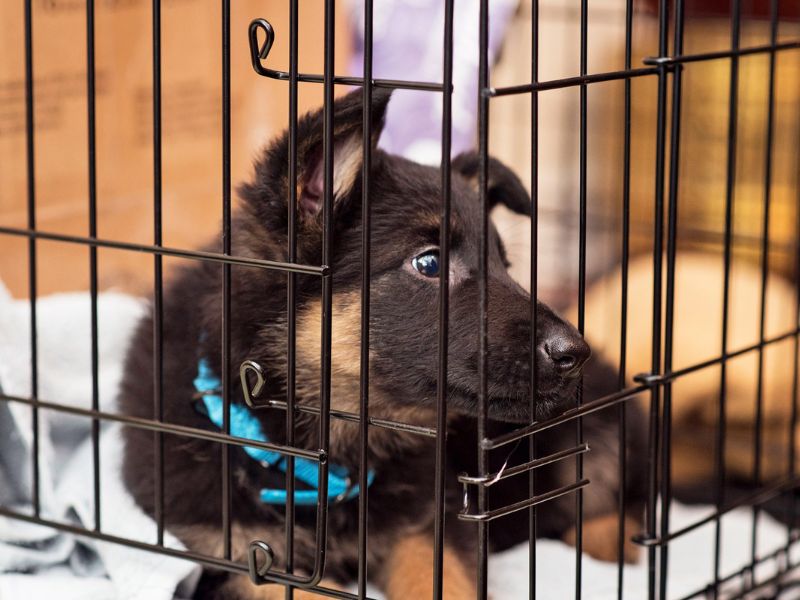
Let your dog spend a longer period in a crate once it has a positive association with going inside.
If you want your dog to calm down during kennel time, play with them and let them go potty first. After that, give them their toy to play with in the crate, and keep an eye on your dog. At that time, gradually try to close the door and see how it reacts.
If you hear your dog barking, whimpering, or pawing at the crate, it’s time to let it out. Then, please repeat this step until the dog stops showing signs of anxiety in the crate.
Step 4: Extend the Time To Crate Train A Puppy
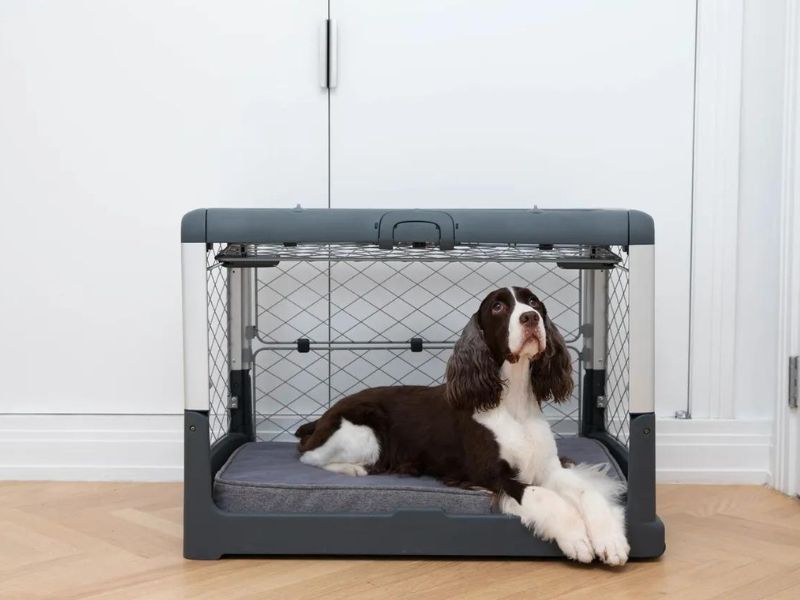
You can start using a dog crate for training once your dog eats regular meals in the crate without showing any signs of fear or distress. That time you can add the verbal cue “kennel up” which will work to get your dog inside.

It’s time to wait silently by the crate for five to ten minutes and then leave the room. Come back, wait a few more minutes until your puppy sits calmly, and then release it from the crate. Repeat it several times a day and extend the time you leave him in the crate and out of his sight. Once your dog can peacefully spend 30 minutes in the crate, you can leave him in the crate for short periods and let him sleep there for the first few nights.
Step 5: Complete crate training a puppy
Part A: Crate training for dogs when left alone

Once your dog can stay 30 minutes in his crate without showing signs of anxiety or fear, you can start leaving him in the short periods you’re gone. The crate should also include some treats and safe toys to play with. Remember to not take it into the crate for more than five or twenty minutes before leaving. Shortly after your dog enters the crate, praise him, reward him with a treat, and leave the room quietly.
Remember that you shouldn’t leave a new dog for longer periods of time in the crate alone.
Part B: Nighttime crate training
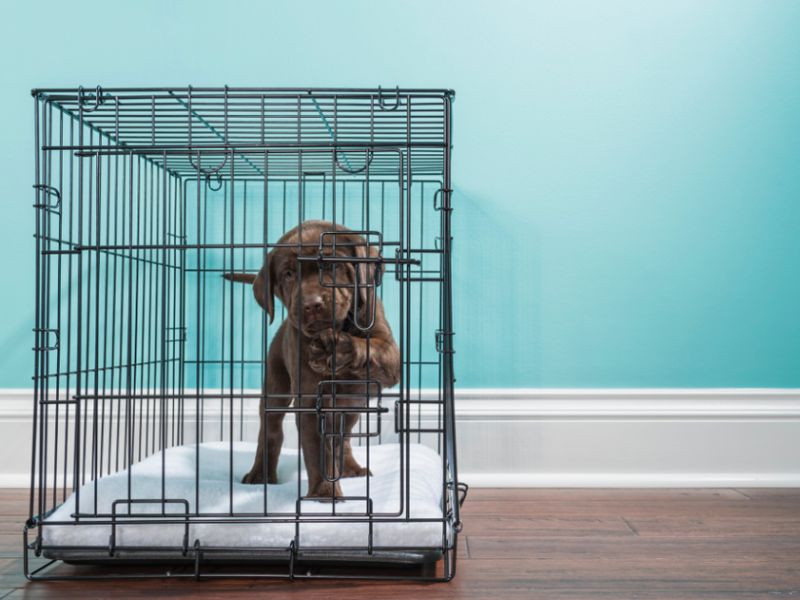
Use your verbal cue to ask the puppy ready for commands and give your dog a treat to make it enter the crate. Make sure you hear your dog barking because it needs to go potty. Repeat this step in the first few nights to make consistent training steps so that your dog altogether spends the night in the crate.
How to Handle The Potential Problems?
Too much crate time
To train your dog, a crate will not solve all your problems. A frustrated and confined dog is the result of improper use. If you leave a young puppy in a crate all day while you’re at work and then have a long nighttime crate training, it will spend too much play time in a too-tiny own space. If you decide to bring your dog on the trip, remember never to leave your dog crated in the car alone, even with the windows open.

That’s why there have to be further preparations made to meet your dog’s psychological and physiological requirements. Remember that young puppies under six months old shouldn’t spend more than three or four hours at a crate time.
Whining
It might be hard to tell if your new pup is whimpering or crying because it wants to be let out of the crate or because puppy needs to go outside to the bathroom at night. It can be explained that dogs have not been rewarded or want to see how you react. In this case, yelling and banging on the crate would make things more stressful for dogs. The dog owners should check out some tips below:
- Ignore your dog for a few seconds, and if the whimpering persists, use the term he identifies with using the bathroom outside. Take your dog out if it reacts positively and gets thrilled.
- Ignoring his whining is the best action if you’re sure your dog doesn’t need to go potty break.
Hence, you should not give in to your dog’s whining, or it will understand that it is an effective way to get out. You may have to restart nighttime crate training from the beginning if the situation worsens beyond your control.
Separation anxiety
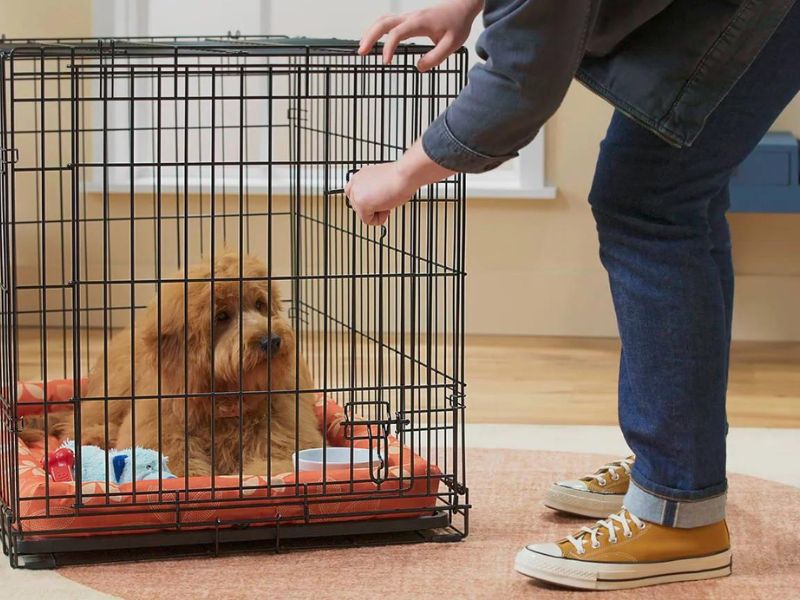
Attempting to treat separation anxiety using the puppy’s crate is futile. Your young puppy may be less disruptive if crate trained, but your dog could hurt itself trying to get out. Only through counter-conditioning and desensitization can most dogs overcome separation anxiety issues.
Advanced Tips And Tricks For Crate Training For Dogs
Where Should You Put The Dog’s Crate?
The most important thing to remember is to help your new puppy adjust to its new home by spending the first few evenings with it. This phase is essential for your house rules.
First, put a new puppy crate next to your bed, in the same room as you are. Get yourself a solid seat, table, or bedside table. If your puppy at night starts to cry, you can calm down it by placing your fingers in the crate.
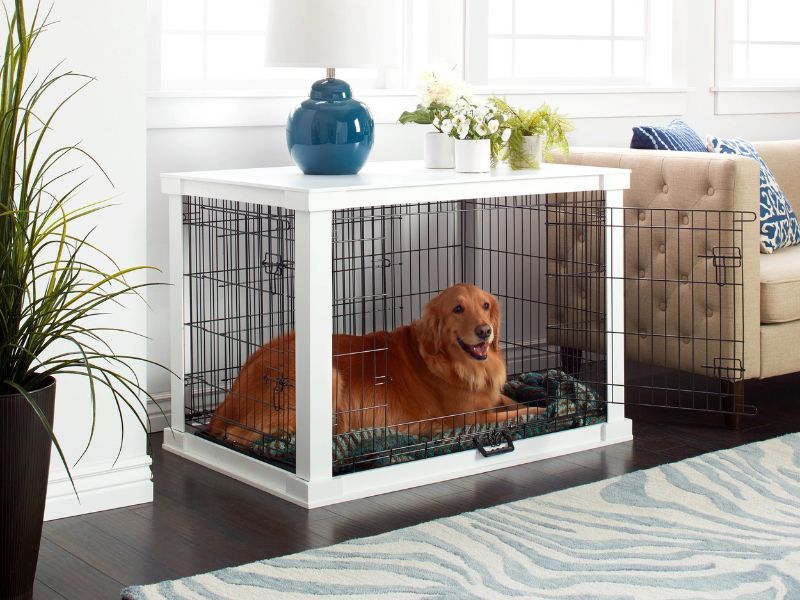
Once your dog becomes acclimated to it, you should gradually increase the distance. You can slowly move the crate away from the bed and place it in the family room, where it will most likely sleep. Your dog will fit right in with your family when it has reached that phase.
Create a Bedtime Routine Before Crate Time
Puppies require a regular sleep schedule and positive associations, like dog owners. It’s an effective measure for avoiding nighttime potty break accidents and other disruptive mishaps for your puppy at night. In addition, it helps put your puppy to sleep. Before you put your dog to bed, you might consider performing these things.
Make Food and Water Timing Plans
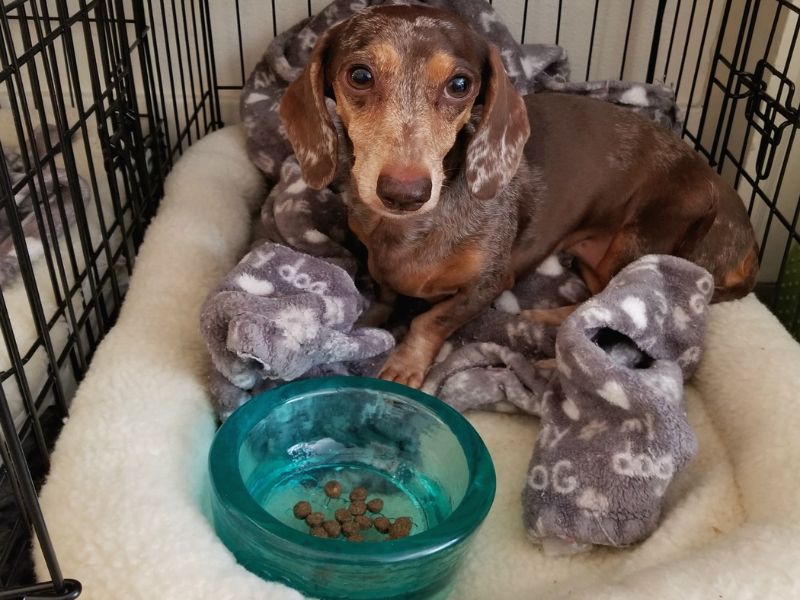
Dinner should be given to your dog plenty of time before bedtime. Your puppy can digest and relieve itself before potty breaks and sleep. In the last hour before your dog’s bedtime, reduce the amount of water it drinks.
Winding-down Routine To Crate Train A Puppy
Most dog owners have different ideas about how a dog should wind down before going to bed. Do you put your puppy to sleep by playing with it or taking it for a long walk? Or do you cuddle and pet your puppy to make it feel better?
It’s a method to tell the dog to relax. Just make sure pet parents stick to their decision. The dogs will learn, follow the consistent routine, and look forward to it.
Noticeable Things
The following simple tips will help speed up the crate training process:
Before introducing your dogs to the crate, always take them outside for a potty break. After letting them go for potty breaks, take them straight back out. Remember that your dog may need to go out more often because of play and excitement.
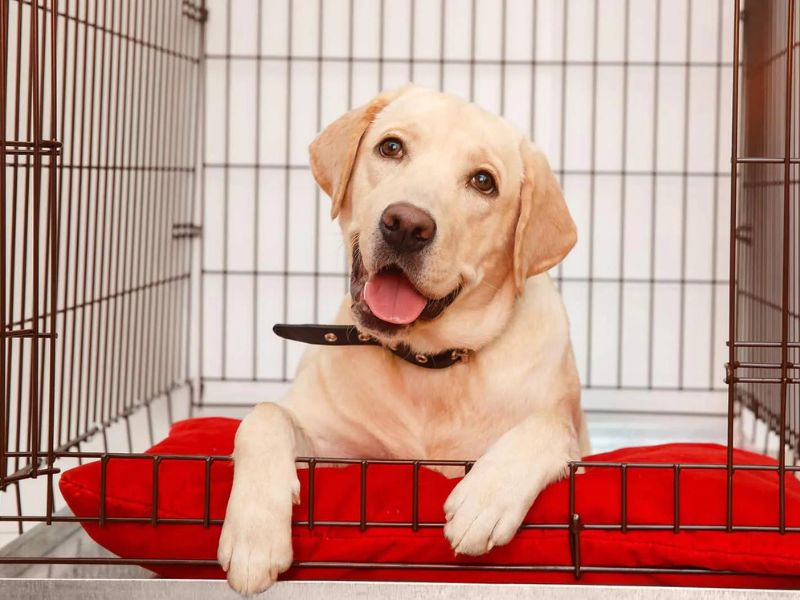
Under no circumstances should you crate train a puppy for more than three hours at a time. If your puppy is really young or very little, its bladder may not be formed enough to hold its urine for even three hours. A puppy four months’ age has the stamina to play for four hours. This information can help you estimate how long you should crate train your puppy.
- 8–10 weeks old: 30–60 minutes
- 11–14 weeks old: 1–3 hours
- 15–16 weeks old: 3–4 hours
- 17+ weeks old: 4–5 hours
If your dog is younger than six or eight months old and you plan to crate them overnight, you should take them out at least once during the potty break.
Making your dog’s crate a pleasant place to be is done by feeding them. Put the dog’s meals next to the crate if they refuse to eat inside, then move treats inside the crate and ultimately to the back.
It’s important to remember that a dog that whines in a puppy’s crate for a few minutes after the potty break is probably just getting comfortable again.
Putting a dog in a crate as a form of punishment is entirely unacceptable. The most crucial part of a crate train is making sure your dog will spend time in the crate.
Consistent repetition is the foundation of any dog’s training. Keeping your dog’s behavior and routine constant is crucial if you want it to learn to be a family member. Puppies will benefit from having a regular evening routine to prepare for sleep. Your puppy’s crate train in daytime efforts will pay off when it spends time there contentedly sleeping.
>>>Further reading:
- 10 Crate Games For Dogs to Keep Your Pup Happy & Entertained
- 15 Best Dog Training Tips & Why Teaching Dogs is Important?
The benefits of crate training for dogs are worth the time and effort required to achieve them. When young puppies have completed crate training, they are less likely to exhibit unwanted behaviors, are generally happier, and reduce separation anxiety. We hope this article from the Canvas Personalized will assist you, as pet parents, in developing a healthy bond with your dog during the crate training process.



